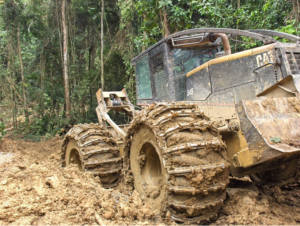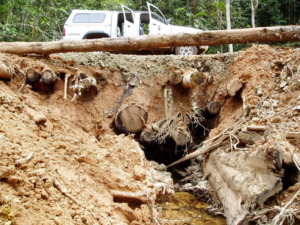Module 6: Forest Types as Related to Their Management
Topic 6.1: Primary, Secondary, and Degraded Forests
Most forests can be characterized as mosaics of patches or stands in different stages of recovery following natural or anthropogenic disturbances. Forest perturbations vary in size, intensity, and frequency. For example, natural disturbances range in size from gaps opened by the death of isolated trees due to pathogen attack to huge swaths of forests blown down by hurricanes and then subjected to high intensity fires. Forest structure and composition, as well as the most appropriate silviculture treatments and the sizes of treated areas are much related to the nature of the disturbances to which a forest has been subjected historically.
Disturbances vary in intensity, that is, in the extent to which the vegetation and soil are damaged. Even gaps opened by the death of single canopy tree vary depending on whether the tree died standing and fell apart piecemeal, suffered stem breakage but retained the capacity to resprout, or was uprooted and thereby exposed mineral soil and buried dormant seeds. Processes of regeneration in canopy gaps of the same size but formed in different ways can be quite different. For example, some gaps are closed by resprouting trees whereas others become dominated by weedy species germinating from the population of formerly buried dormant seeds. Similarly, due to the effects of soil disturbance regeneration in canopy gaps opened during ground-based timber harvesting is likely to differ from regeneration in natural gaps or in gaps from which logs were extracted by helicopter or with a skyline yarder.
Wildfires and controlled burns also vary a great deal in intensity. Fire intensity is a function of fuel characteristics (biomass, distribution, flammability, and moisture content), atmospheric condition (temperature, humidity, and wind speed), and fire type. Fires that burn into the wind (=backing fires) tend to move more slowly, burn at lower temperatures and consume more fuel than fires that go with the wind (=head fires). Local accumulations of fuel (e.g., where the crowns of felled trees are piled) can lead to great spatial variation in fire intensity. Whether a fire burns hot or relatively cool, and quickly or slow, influences whether trees and other plants are top-killed. Likelihood of root system death varies with species, season, and fire intensity. Historical frequency of disturbance is another factor to consider when designing silvicultural treatments that mimic natural conditions. Forests subjected to frequent hurricanes or fires will obviously present different silvicultural challenges than forests in which such cataclysmic disturbances are rare. Furthermore, given the burgeoning human populations on most tropical forest margins, fires are likely to continue to increase in frequency and continue to present challenges for forest managers. Also, according to many global climate change models, global warming due to increased concentration of atmospheric heat trapping (“greenhouse”) gases, the frequency of severe tropical storms is predicted to increase during the next decades.
After a disturbance there are many different modes of regeneration. Small canopy gaps can be closed by lateral expansion of neighboring crowns. Stem and root sprouts are often the primary modes of regeneration after moderate to low intensity disturbances. Where advanced regeneration of canopy trees is abundant and survives the disturbance, it may dominate the regeneration process. Seedlings emerging from buried seeds and seeds dispersed into the area after the disturbance can abound, especially where the disturbance destroys the pre-existing vegetation, disturbs the soil, and otherwise exposes a seed bed of mineral soil.
To select the appropriate set of silvicultural treatments, the forester must be able to “read” the forest. Reading the forest entails recognizing any edaphic limitations (e.g., very erodible soil) and knowing about the regeneration and growth requirements of commercial, not-yet commercial, and weedy species. Field observations on the size distributions of commercial species in areas with different canopy cover often provides critical clues about regeneration requirements. For example, if seedlings and saplings of most canopy trees abound on roadsides and in abandoned agricultural clearings but are very uncommon or absent in the understory, there is good reason to suspect that the present canopy trees regenerated after some fairly large scale and intensive disturbance. Determining how large and how intense this disturbance might have been requires more evidence. Often this evidence is not obvious due to superimposed disturbances (e.g., fire after a windstorm) that are also spatially heterogeneous. Furthermore, lack of current disturbance is often misleading; many forests are characterized as having long relatively disturbance-free periods punctuated by short intervals of severe disruptions.
Many forests designated for silvicultural management in the tropics have a history of human intervention. It behooves forest managers to avail themselves of site histories provided by -local residents, written reports, old aerial photographs, charcoal scars on large trees, charcoal in the soil, and archaeological evidence. More than one manager has mistakenly assumed a forest to be virgin while standing on fairly evident archeological remains!
Mimicking natural disturbances with silvicultural treatments seems like a reasonable way to regenerate the forest for commercial purposes while not endangering species or ecosystem processes. Where the most common disturbance is a small canopy gap, employing single tree or group selection seems eminently appropriate. But where the current canopy regenerated after a large scale cataclysmic disturbance, the appropriate approach to silviculture may be environmentally less attractive or feasible. In such forests the challenge is to design minimum-impact treatments that satisfy the silvicultural goals while protecting ecosystem functions and protecting biodiversity.
Many managed forests have legacies of recent human activities that modified forest structure and composition, thereby constraining silvicultural options. Logged-over forests (= high-graded, or creamed) are generally depleted in the most valuable tree species and may have serious weed infestation that require control. Secondary forests that develop on abandoned agricultural lands, depending on the time since abandonment and site conditions, can be easier to manage than old growth forests due to high stocking of fast growing trees of at least modest value for timber. For both logged over and secondary forests, extensive reconnaissance and intensive inventory data are often needed to select the best silvicultural treatments. Sometimes the most reasonable silvicultural option is to do nothing, at least until the forest naturally recovers to the extent that silvicultural treatments (e.g., weed control or liberation of future crop trees) are likely to be successful and cost effective.
As the old-growth (=primary) forests of the world disappear, natural forest managers will have to pay increasing attention to forests that have already been logged and forests that develop on abandoned agricultural lands and other clearings (=secondary forests). Old growth forests, often defined as forests that have not been seriously disturbed for more than 100 years), are generally the richest from the timber perspective, but present their own peculiar challenges to the forest manager.
The large valuable trees that make old-growth forest so attractive to loggers, also make them difficult to manage. First of all, large trees, and the large logs that they supply, are hard to handle, requiring either heavy equipment or break-down sawing into more manageable sections in the forest. After quarter-sawing with chainsaws or any of a variety of portable band saw rigs (=“walkabout” saw mills; also referred to as pit sawing), even the largest logs can be skidded with light equipment or draft animals. But in most industrial logging areas, large logs are yarded with large bulldozers that are very damaging to soil and the residual vegetation. The other major problem for managers of old-growth forest derives from the excessive potential profits from timber harvesting. It is difficult to resist pressure to log quickly and to extract large volumes of timber often without adequate planning, worker training, or supervision.
Silvicultural characteristics of logged forests depend on many factors, but often the most and bridges need to be breached and other water impoundments created by poorly located skid trails and roads need to be drained. Where mineral soil is still exposed and eroding on roads and skid trails, soil stabilization by re-contouring, installation of erosion-control structures, and planting cover crops is often needed. Restoring the productivity of compacted soils is sometimes possible by disking or ripping, but these treatments do not always result in long-term increases in soil aeration and decreases in soil bulk density.important relate to the type and intensity of previous logging operations. After heavy logging by untrained and unsupervised crews using bulldozers, the residual forest can present major silvicultural challenges (Figure 6.1.1). Complicating the low standing volumes of timber in logged-over forest, many of the standing trees received wounds that make them susceptible to heartrot development and insect attack. Uncontrolled logging also increases forest susceptibility to fires due to decreased humidity and increased abundance of flammable materials near the ground. Soil loss and compaction in highly degraded forests may decrease productive substantially on up to 20-40% of the area. Major canopy opening can stimulate the prolific growth of vines, bamboo, and other light-demanding, disturbance-adapted plants, many of which are silvicultural weeds.

Figure 6.1.1. Unnecessarily destructive logging with heavy equipment (i.e., a skidder with pneumatic tires) on wet soil with very large logs
The first steps towards silvicultural management of badly logged-over forests are often directed towards restoring ecosystem functions. To restore hydrological processes, collapsed culverts and bridge abutments need to be removed so stream flow is restored (Figure 6.1.2).

Figure 6.1.2. A wooden stringer bridge for which the soil backed abutments are about to collapse, blocking the stream at least temporarily and filling it with sediment.
Before timber can be effectively produced in some badly degraded sites, weed control is required. If 50-75% of the residual trees are covered by vines, for example, vine control may be a prerequisite to growing the tall straight trees desired by the timber industry.
Cost of silviculturally treating badly damaged forests can be extremely high. Obviously it is best to avoid allowing these conditions to develop by controlling logging. Where uncontrolled logging occurred and the forest is composed of stands with different degrees of degradation, a “triage” system may be appropriate: some stands will recover without intervention and should be left alone; some stands will not recover without excessive expenditures of time and money and should be left to recover on their own after the major hydrological disruptions have been repaired; and, some stands are likely to respond well to silvicultural treatments and should be the major focus of attention. The analogy with triage systems for dealing with wounded soldiers seems harsh but realistic for damaged forests.
Forests that develop on abandoned agricultural lands and pastures have some silvicultural advantages and some disadvantages. Where the clearings were not large, land use was not intensive (e.g., the soil was not plowed or the site not heavily grazed), and forest seed sources are nearby, secondary forest that is well stocked with marketable timber species may develop. During the first few years after abandonment, shrubs and short-lived pioneer trees may dominate the site. At the same time, however, longer-lived light-demanding trees with better silvicultural properties may be developing. When these so-called “long-lived pioneers” emerge above the tangle, the stands are often prime for silvicultural treatments such as vine cutting, thinning, or liberation.
Secondary forests that develop underneath scattered trees from the original forest present an added silvicultural challenge: what to do with the large, remanent trees that are generally not merchantable due to poor form, hollow stems, or other defects? Generally it is best to leave these “wolf” trees alone because they do not use many soil resources or cast dense shade, they provide some semblance of forest structure, and they are often much used by wildlife as nesting, perching, or denning sites. Furthermore, felling or even arborciding these trees may do an unacceptable amount of damage to the regenerating stand.
